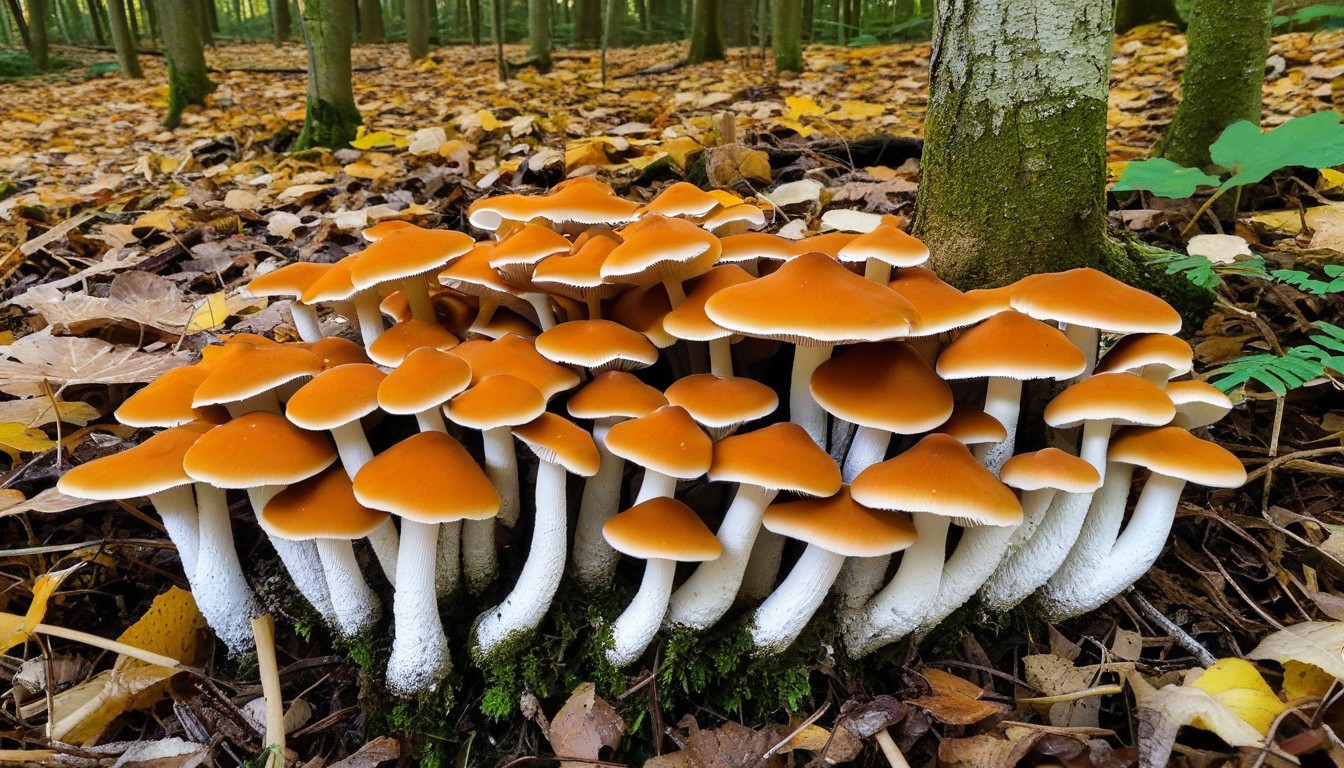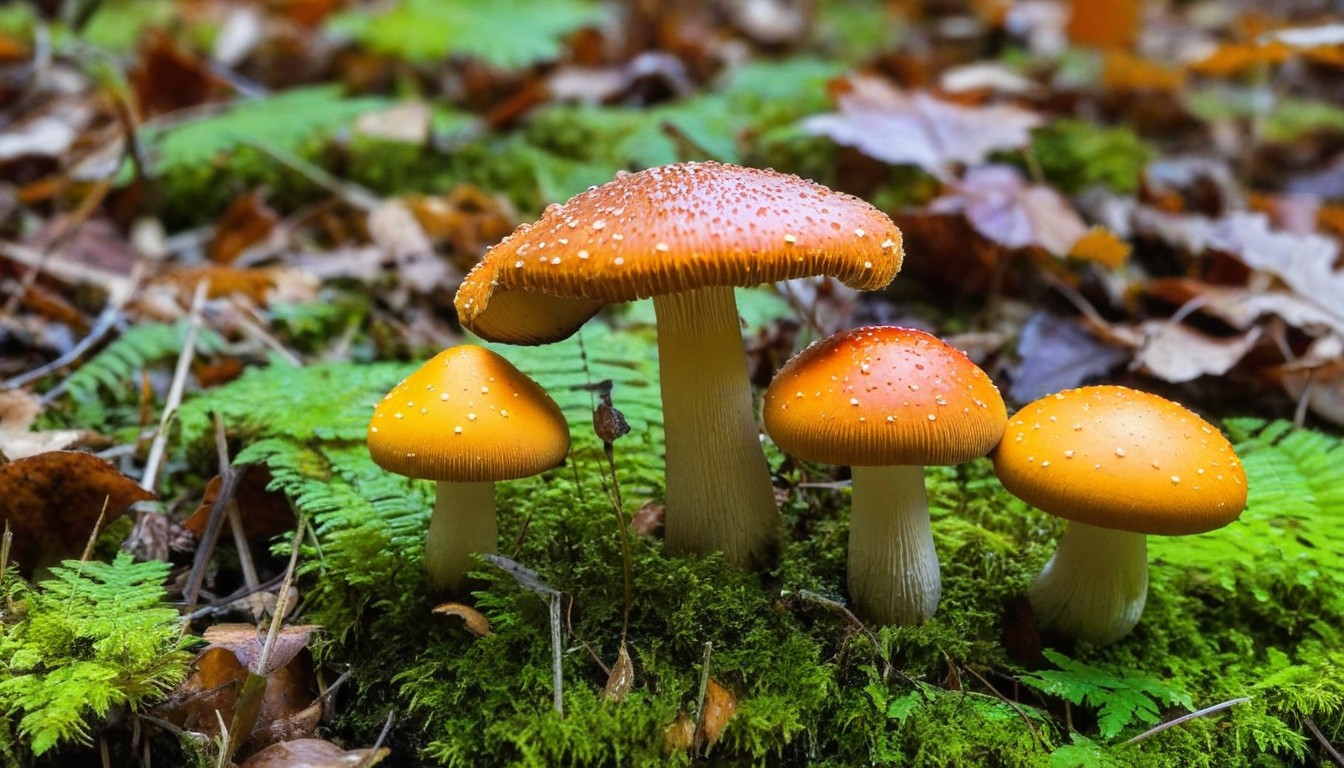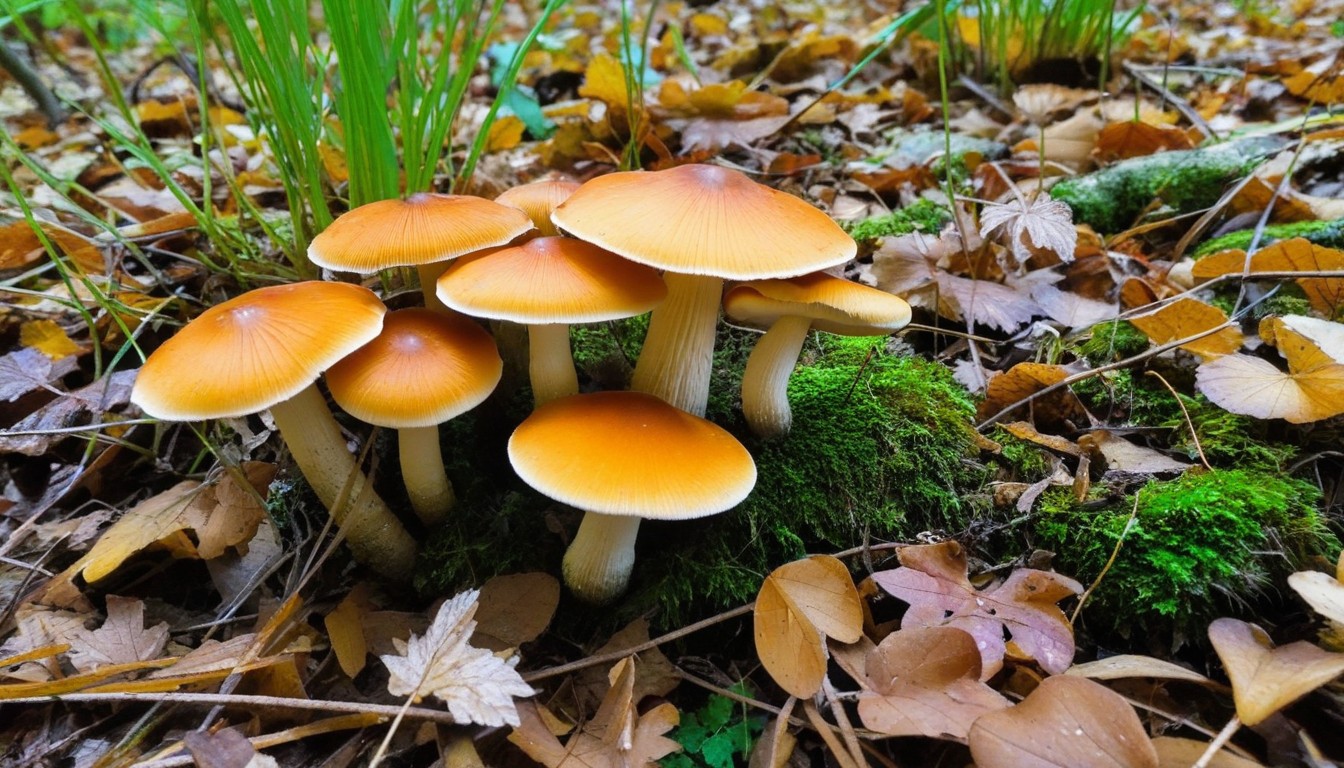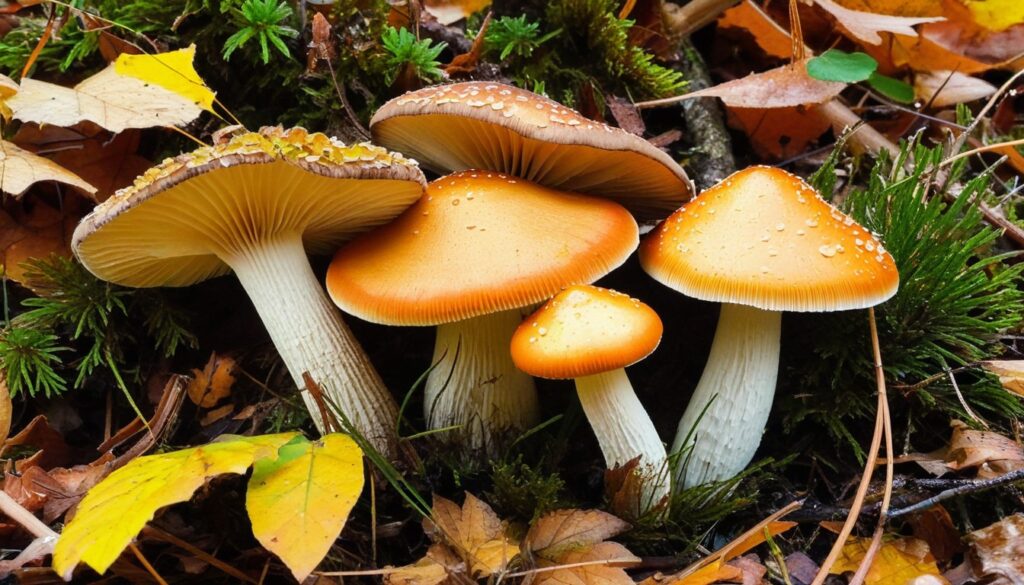Welcome to our comprehensive guide on exploring the world of Fall mushrooms in Missouri! Missouri’s diverse forests offer the perfect habitat for a wide range of mushroom species, making it a premier location for mushroom enthusiasts and foragers alike. In this article, we’ll take you on a journey through Missouri’s forests, highlighting the best spots for mushroom foraging and providing helpful identification tips and sustainable harvesting practices.
Key Takeaways
- Missouri’s forests offer the perfect habitat for a diverse range of Fall mushrooms
- Our guide will provide tips and tricks for identifying and sustainably harvesting mushrooms in Missouri
- You’ll also discover the vital role that Fall mushrooms play in Missouri’s ecosystems
- Learn about edible and poisonous mushrooms in Missouri and how to safely consume them
- Find out about upcoming events and festivals to connect with other mushroom enthusiasts and experts
Why Fall Mushrooms Thrive in Missouri’s Forests
Missouri’s forests provide the ideal environment for Fall mushrooms to flourish. The state’s diverse geography and climate, combined with the abundance of deciduous trees, create the perfect conditions for these fungi to thrive. Additionally, the nutrient-rich soil, ample rainfall, and moderate temperatures characteristic of Missouri’s forests provide optimal growing conditions for a variety of mushroom species.
The prevalence of oak, hickory, and maple trees in Missouri’s forests is a significant contributing factor to the thriving Fall mushroom population. These trees have a mutually beneficial relationship with mushrooms, with the fungi deriving essential nutrients from the trees’ roots in exchange for aiding the trees in extracting water and nutrients from the soil.
The extensive network of mycelium, the vegetative part of mushrooms, that extends throughout the forest floor plays a crucial role in maintaining the forest ecosystem. Mycelium breaks down organic matter, including dead trees and other plant material, and incorporates them back into the soil, providing valuable nutrients for other plant life to grow.
Overall, Missouri’s forests offer a perfect habitat for diverse mushroom species to grow and play a vital role in maintaining the state’s forest ecosystem.
Top Mushroom Foraging Spots in Missouri
Are you ready to explore the best mushroom foraging spots in Missouri? Here are some of the top locations to discover a diverse range of Fall mushrooms:
|
Park/Forest |
Location |
Notable Mushroom Species |
|---|---|---|
|
Mark Twain National Forest |
Southern Missouri |
Maitake, Chanterelles, Hen of the Woods |
|
Ha Ha Tonka State Park |
Lake of the Ozarks |
Morels, Chicken of the Woods, Puffballs |
|
Finger Lakes State Park |
Columbia |
Lions Mane, Oyster, Shiitake |
|
Katy Trail State Park |
Sedalia |
Black Trumpet, Hedgehog, Lobster |
|
Mizzou Botanic Garden |
Columbia |
Maitake, Lion’s Mane, Reishi |
Mark Twain National Forest
Located in Southern Missouri, Mark Twain National Forest provides an idyllic setting for Fall mushroom hunting. With its scenic hiking trails and lush vegetation, it’s an ideal location for finding Maitake, Chanterelles, Hen of the Woods, and other savory mushroom species.
Ha Ha Tonka State Park
Located by the Lake of the Ozarks, Ha Ha Tonka State Park is another great destination for mushroom hunters. Its thick forests and rocky ledges provide a prime habitat for Morels, Chicken of the Woods, and Puffballs, among other species.
Finger Lakes State Park
If you’re hunting for edible mushrooms, Finger Lakes State Park is a top-notch spot to explore. With a variety of trees, including oak, hickory, and maple, it’s a prime location for Lion’s Mane, Oyster, and Shiitake mushrooms.
Katy Trail State Park
As one of the longest parks in the US, Katy Trail State Park is an excellent choice for a scenic hike while foraging for mushrooms. Its shady woods make a perfect habitat for Black Trumpet, Hedgehog, and Lobster mushrooms, which grow in clusters and are often found on rotting logs.
Mizzou Botanic Garden
If you’re in Columbia, Missouri, check out Mizzou Botanic Garden. While it’s not a traditional foraging spot, it boasts a variety of mushroom species, including Maitake, Lion’s Mane, and Reishi, which are often cultivated for their medicinal properties and delicious flavors.
Identifying Fall Mushrooms in Missouri

Exploring the vast world of Fall mushrooms in Missouri can be a thrilling and rewarding experience for nature lovers and foragers alike. However, it’s crucial to learn how to identify different species correctly to avoid potential risks associated with toxic mushrooms. Follow our tips to enhance your ability to correctly identify these fascinating fungi.
Key Identification Features:
“A cap, gills and stalk identify most mushrooms” – Gary Lincoff
Pay close attention to the cap, gills, stalk, and spore print to differentiate between different mushroom species. The cap shape, size, and color can vary significantly and may provide useful clues to identify a specific type of mushroom. Gills attached to the underside of the cap come in different shapes, sizes, and colors and are a crucial identifying feature for many species. The color, height, and texture of the stalk also provide valuable information, along with the spore color and shape. Remember to collect a spore print on white paper by leaving the cap on the paper overnight to compare it with the available spore references.
Mushroom Identification Resources:
There are many resources available to help with mushroom identification, including field guides, online forums, and experienced foragers. Joining local groups and attending mushroom identification outings is one of the best ways to learn more about fungi and engage with knowledgeable individuals in the field. Some helpful resources to start with include:
- Mushrooms of the Midwest field guide by Michael Kuo and Andrew Methven
- Mushroom Observer online forum in Missouri
- The Missouri Mycological Society
With practice and education, you can develop a keen eye for distinguishing between different Fall mushroom varieties. Don’t hesitate to seek help from experts and always prioritize safety when foraging.
Edible Fall Mushrooms in Missouri
If you’re interested in foraging for edible mushrooms in Missouri, there are several species that you can safely add to your plate. Some of the most popular edible fall mushrooms in Missouri include:
|
Mushroom |
Description |
Best Harvesting Time |
|---|---|---|
|
Chicken of the Woods |
A bright orange and yellow polypore that grows on dead or dying trees |
Late summer to early fall |
|
Hen of the Woods |
A gray-brown mushroom with a ruffled cap that grows in clusters at the base of trees |
Late summer to early fall |
|
Black Trumpet |
A delicate, funnel-shaped mushroom with a smoky, earthy flavor |
Late summer to early winter |
|
Chanterelle |
A bright yellow-orange mushroom with a fruity and slightly peppery flavor |
Late summer to early fall |
When foraging for edible mushrooms, it’s important to correctly identify the species. Always consult a reliable field guide and avoid consuming any mushroom that you’re not 100% certain is safe to eat.
It’s also crucial to properly prepare and cook your mushrooms to ensure their safety and enhance their flavor. Avoid eating them raw, and always clean and cook them thoroughly before consumption.
With these tips in mind, you’re ready to embark on a delicious and satisfying culinary journey through Missouri’s fall mushrooms.
Poisonous Fall Mushrooms in Missouri

While foraging for mushrooms in Missouri’s forests can be a thrilling experience, it’s important to exercise caution and be aware of the types of mushrooms that can be harmful if ingested. We’ve compiled a list of common poisonous fall mushrooms in Missouri, along with key identification features:
|
Mushroom Name |
Identification Features |
|---|---|
|
Destroying Angel |
White, smooth cap; white stem with a cup-like base; gills firmly attached to the cap |
|
Deadly Galerina |
Brownish-orange cap; brown stem with a ring near the top; gills are rusty brown |
|
Panther Mushroom |
Orange-red cap with dark scales; white stem with dark scales at the base; gills are white or yellowish |
If you’re unsure about the identification of a mushroom, it’s best to err on the side of caution and avoid ingesting it. Always thoroughly wash your hands after handling mushrooms, and do not consume wild mushrooms raw. Cook all mushrooms at high temperatures to eliminate any potential toxins.
By being informed about the potential dangers of poisonous fall mushrooms in Missouri, you can safely enjoy the rewards of mushroom foraging in this beautiful state.
Wildlife and Ecosystem Contributions of Fall Mushrooms in Missouri
Did you know that Fall mushrooms in Missouri are essential to maintaining healthy ecosystems?
These fascinating fungi perform significant roles in sustaining forest habitats by helping to decompose organic matter, providing food and nutrients for wildlife, and enriching the soil by enhancing nutrient cycling. They also have a crucial role in the complex web of interactions between the different organisms in Missouri’s forests, affecting the biodiversity and balance of its ecosystems.
The relationship between Fall mushrooms and forest animals is also noteworthy. Many wildlife species rely on mushrooms for sustenance, and some even use them as a form of medicine. Mushrooms that have grown through decayed wood and plants can attract insects such as ants, which can then bring in other animals, creating a thriving ecosystem dependent on these fungal wonders.
The incredible symbiosis between Fall mushrooms and the environment in Missouri makes them a vital component in maintaining forest health and promoting biodiversity. So, taking sustainable harvesting practices to preserve these fungi’s populations is crucial because Fall mushrooms are an essential part of Missouri’s rich natural heritage.
Sustainable Mushroom Foraging Practices in Missouri

If you love mushroom foraging in Missouri, it’s essential to engage in sustainable practices to ensure long-term preservation of these precious fungi. Here are some guidelines to follow:
|
Guidelines for Sustainable Mushroom Foraging in Missouri |
|---|
|
Harvest only what you need: Avoid taking more mushrooms than you can use. Leave some for wildlife and other foragers. |
|
Be mindful of your impact: Avoid damaging the environment when foraging, and stay on designated trails when possible. |
|
Identify your mushrooms: Properly identifying mushrooms before picking can prevent the accidental harvesting of poisonous species and preserve populations of rare mushrooms. |
|
Preserve mushroom habitat: Avoid harvesting in areas where mushrooms are sparse, and refrain from removing entire mushroom clusters or destroying their surrounding habitat. |
|
Spread awareness: Educate yourself and others on sustainable mushroom foraging practices to contribute to the preservation of Missouri’s rich ecosystems. |
By following these guidelines, you can enjoy the delicious and fascinating world of mushrooms while contributing to the longevity of Missouri’s natural resources.
Fall Mushroom Events and Festivals in Missouri
Experience the wonder of Fall mushrooms by attending one of Missouri’s many events and festivals. These gatherings offer a fantastic opportunity to meet fellow mushroom enthusiasts, participate in educational activities, and sample delicious mushroom-based dishes.
Mushroom Festival
|
Name |
Date |
Location |
|---|---|---|
|
Mushroom Festival |
September 18-19, 2021 |
Richland, MO |
One of the most popular mushroom events in Missouri, the Richland Mushroom Festival is a celebration of all things fungal. With guided mushroom hunts, cooking demonstrations, and live music, this is an event that should not be missed!
Foray with the Missouri Mycological Society
Join the Missouri Mycological Society for an exciting mushroom foray and workshop!
|
Name |
Date |
Location |
|---|---|---|
|
Foray with the Missouri Mycological Society |
October 2, 2021 |
Rockwoods Reservation, MO |
This educational experience is perfect for those who want to learn about mushroom identification and are looking to take their mushroom foraging skills to the next level! Authentic mushroom meals included.
Park Mushroom Walk
Take a scenic autumn walk in one of Missouri’s beautiful state parks, hosted by a park expert guide!
|
Name |
Date |
Location |
|---|---|---|
|
Park Mushroom Walk |
November 7, 2021 |
Ha Ha Tonka State Park, MO |
This event is the perfect way to immerse yourself in nature, learn about the local ecology, and discover some hidden gems on your mushroom foraging journey.
Wherever you are in Missouri, there’s sure to be an event or festival that suits your interests. Don’t hesitate to join in on the celebration and experience the magic of Fall mushrooms in Missouri for yourself!
Resources for Further Exploration of Fall Mushrooms in Missouri

Now that you’ve discovered the wonders of Fall mushrooms in Missouri, it’s time to deepen your knowledge and hone your foraging skills. Here are some recommended resources to assist you on your journey:
Books
- Mushrooms of the Midwest by Michael Kuo and Andrew Methven
- Missouri Wildflowers by Edgar Denison
- The Mushroom Hunter’s Field Guide: All-New Edition by Alexander H. Smith and Nancy Smith Weber
Websites
- Missouri Botanical Garden – Mushrooms
- Missouri Mycological Society
- The Mushroom Forager – Mushroom Identification
Organizations
- Missouri Ozark Group of the Sierra Club
- Missouri State University – Michler Lab
- National Park Service – Ozark National Scenic Riverways – Mushrooms
Foraging Courses and Workshops
|
Name |
Location |
Description |
|---|---|---|
|
Midwest Wild Harvest Festival |
Prairie du Chien, Wisconsin |
A weekend-long festival featuring workshops, lectures, and forays on wild mushrooms and other edible wild foods. |
|
Missouri Mycological Society Foray |
Various locations in Missouri |
A gathering of mushroom enthusiasts for forays, lectures, and identification sessions. |
|
Foraging and Wildcrafting Course |
Eminence, Missouri |
A six-day course covering plant identification, harvesting techniques, and preparation of wild foods including mushrooms. |
With these resources in hand, you’ll be well-prepared to continue your exploration of the fascinating world of Fall mushrooms in Missouri.
Conclusion
Thank you for joining us on this journey to discover the wonders of Fall mushrooms in Missouri. We hope that this guide has provided you with valuable insights and information to enhance your mushroom foraging experience.
As you embark on your mushroom adventures, always remember to prioritize sustainable practices and ethical harvesting. By doing so, we can ensure the preservation and protection of Missouri’s diverse mushroom populations for generations to come.
Don’t forget to attend the exciting Fall mushroom events and festivals held throughout Missouri, where you can connect with fellow enthusiasts and learn from experts in the field.
Stay curious and continue to explore the fascinating world of Fall mushrooms in Missouri. Happy foraging!
FAQ
Are all Fall mushrooms in Missouri edible?
No, not all Fall mushrooms in Missouri are edible. It is important to learn how to identify different species and consult with experts before consuming any wild mushrooms.
What are some popular edible Fall mushrooms in Missouri?
Some popular edible Fall mushrooms in Missouri include the Hen of the Woods, Chanterelles, and Morels. These mushrooms are known for their unique flavors and culinary uses.
How can I safely identify Fall mushrooms in Missouri?
To safely identify Fall mushrooms in Missouri, it is recommended to consult field guides, join mushroom foraging groups, and learn from experienced foragers. Pay attention to key identification features such as color, shape, and texture.
Are there any poisonous Fall mushrooms in Missouri?
Yes, there are poisonous Fall mushrooms in Missouri. Some common toxic species include the Death Cap and the Destroying Angel. It is crucial to avoid consuming any mushrooms that you are not completely confident in identifying.
Are there any Fall mushroom events or festivals in Missouri?
Yes, Missouri hosts various Fall mushroom events and festivals. These events provide opportunities for mushroom enthusiasts to learn, explore, and connect with others who share a passion for mushrooms. Check local event listings for details.
How can I practice sustainable mushroom foraging in Missouri?
To practice sustainable mushroom foraging in Missouri, it is important to follow ethical harvesting practices. Leave some mushrooms behind to allow for natural reproduction, and avoid damaging the surrounding environment while foraging.
Are Fall mushrooms important for Missouri’s ecosystems?
Yes, Fall mushrooms play a vital role in Missouri’s ecosystems. They contribute to nutrient cycling, provide habitat for wildlife, and help maintain the overall health and balance of the forest ecosystem.
Where can I find additional resources for exploring Fall mushrooms in Missouri?
There are various resources available for further exploration of Fall mushrooms in Missouri. Check out recommended books, websites, and organizations dedicated to mycology to enhance your knowledge and understanding of these fascinating fungi.

